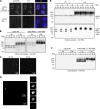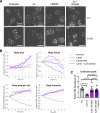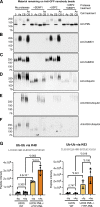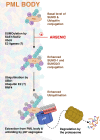The p97/VCP segregase is essential for arsenic-induced degradation of PML and PML-RARA
- PMID: 36880596
- PMCID: PMC10005898
- DOI: 10.1083/jcb.202201027
The p97/VCP segregase is essential for arsenic-induced degradation of PML and PML-RARA
Abstract
Acute Promyelocytic Leukemia is caused by expression of the oncogenic Promyelocytic Leukemia (PML)-Retinoic Acid Receptor Alpha (RARA) fusion protein. Therapy with arsenic trioxide results in degradation of PML-RARA and PML and cures the disease. Modification of PML and PML-RARA with SUMO and ubiquitin precedes ubiquitin-mediated proteolysis. To identify additional components of this pathway, we performed proteomics on PML bodies. This revealed that association of p97/VCP segregase with PML bodies is increased after arsenic treatment. Pharmacological inhibition of p97 altered the number, morphology, and size of PML bodies, accumulated SUMO and ubiquitin modified PML and blocked arsenic-induced degradation of PML-RARA and PML. p97 localized to PML bodies in response to arsenic, and siRNA-mediated depletion showed that p97 cofactors UFD1 and NPLOC4 were critical for PML degradation. Thus, the UFD1-NPLOC4-p97 segregase complex is required to extract poly-ubiquitinated, poly-SUMOylated PML from PML bodies, prior to degradation by the proteasome.
© 2023 Jaffray et al.
Conflict of interest statement
Disclosures: The authors declare no competing interests exist.
Figures













Similar articles
-
RNF4 is a poly-SUMO-specific E3 ubiquitin ligase required for arsenic-induced PML degradation.Nat Cell Biol. 2008 May;10(5):538-46. doi: 10.1038/ncb1716. Epub 2008 Apr 13. Nat Cell Biol. 2008. PMID: 18408734
-
PCGF2 negatively regulates arsenic trioxide-induced PML-RARA protein degradation via UBE2I inhibition in NB4 cells.Biochim Biophys Acta. 2016 Jul;1863(7 Pt A):1499-509. doi: 10.1016/j.bbamcr.2016.03.019. Epub 2016 Mar 24. Biochim Biophys Acta. 2016. PMID: 27030546
-
Arsenic degrades PML or PML-RARalpha through a SUMO-triggered RNF4/ubiquitin-mediated pathway.Nat Cell Biol. 2008 May;10(5):547-55. doi: 10.1038/ncb1717. Epub 2008 Apr 13. Nat Cell Biol. 2008. PMID: 18408733
-
Novel treatment of acute promyelocytic leukemia: As₂O₃, retinoic acid and retinoid pharmacology.Curr Pharm Biotechnol. 2013;14(9):849-58. doi: 10.2174/1389201015666140113095812. Curr Pharm Biotechnol. 2013. PMID: 24433507 Review.
-
The cell biology of disease: Acute promyelocytic leukemia, arsenic, and PML bodies.J Cell Biol. 2012 Jul 9;198(1):11-21. doi: 10.1083/jcb.201112044. J Cell Biol. 2012. PMID: 22778276 Free PMC article. Review.
Cited by
-
BioE3 identifies specific substrates of ubiquitin E3 ligases.Nat Commun. 2023 Nov 23;14(1):7656. doi: 10.1038/s41467-023-43326-8. Nat Commun. 2023. PMID: 37996419 Free PMC article.
-
History of Developing Acute Promyelocytic Leukemia Treatment and Role of Promyelocytic Leukemia Bodies.Cancers (Basel). 2024 Mar 29;16(7):1351. doi: 10.3390/cancers16071351. Cancers (Basel). 2024. PMID: 38611029 Free PMC article. Review.
-
PML mutants from arsenic-resistant patients reveal SUMO1-TOPORS and SUMO2/3-RNF4 degradation pathways.J Cell Biol. 2025 Jun 2;224(6):e202407133. doi: 10.1083/jcb.202407133. Epub 2025 Apr 16. J Cell Biol. 2025. PMID: 40239066 Free PMC article.
-
Concerted SUMO-targeted ubiquitin ligase activities of TOPORS and RNF4 are essential for stress management and cell proliferation.Nat Struct Mol Biol. 2024 Sep;31(9):1355-1367. doi: 10.1038/s41594-024-01294-7. Epub 2024 Apr 22. Nat Struct Mol Biol. 2024. PMID: 38649616 Free PMC article.
-
Targeted protein degradation for cancer therapy.Nat Rev Cancer. 2025 Jul;25(7):493-516. doi: 10.1038/s41568-025-00817-8. Epub 2025 Apr 25. Nat Rev Cancer. 2025. PMID: 40281114 Review.
References
-
- Anderson, D.J., Le Moigne R., Djakovic S., Kumar B., Rice J., Wong S., Wang J., Yao B., Valle E., Kiss von Soly S., et al. . 2015. Targeting the AAA ATPase p97 as an approach to treat cancer through disruption of protein homeostasis. Cancer Cell. 28:653–665. 10.1016/j.ccell.2015.10.002 - DOI - PMC - PubMed
Publication types
MeSH terms
Substances
Grants and funding
LinkOut - more resources
Full Text Sources
Medical
Miscellaneous

